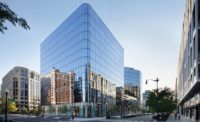New York City
With all the glitzy-hip hotels opening in New York City these days, you could get very tired of the boutique approach that went into full throttle after Ian Schrager and Steve Rubell opened Morgans Hotel in 1984. While that first one was minimal (designed by Andrée Putman), the clever imitations that ensued from the commercial-chain crowd are not.
So it's a relief to discover the sleek and trim 56-room Hôtel Americano next to the High Line in the thick of the Chelsea district in Manhattan. Its industrial–Modernist architecture brushed with touches of luxe fits in well with both the former warehouses containing art galleries and the edgy new apartment buildings nearby. Fortunately, Americano's soigné yet comfortable ambience lacks the desperation and raucousness of so many recent hotel arrivals. The low-decibel sleekness of its architecture by Enrique Norten/TEN Arquitectos of Mexico City and New York and the interior design by MCH (Arnaud Montigny) of Paris could explain why the 10-story caravansary is becoming a casual hangout for artists, architects, and fashion types.
The developer, Mexican hotelier Grupo Habita, found a small 50-by-99-foot lot just west of the High Line, on the site of a former garage, for its first U.S. outpost. The company, founded in 2000 by three brothers—Moisés, Rafael, and Jaime Micha, with their friend Carlos Couturier—had hired Norten as the architect for its first hotel, Habita in Mexico City [Record, March 2001, page 106]. Norten's conversion of a former apartment building into a luminously glass-wrapped volume won a BusinessWeek/Architectural Record award in 2003.
For Norten's reprise in New York, Habita brought in Montigny to design the interiors. Ordinarily such a division would make you fear that architecture would be relegated to mere skin and bones, while the interiors would be plumped up by festoonery and furbelows. Luckily, Montigny, who worked with Japanese architect Kengo Kuma on the Jugetsudo, a tea house in Paris, brings a lean but chic sensibility to the hotel's furnishings and finishings that fits well with Norten's scheme. “The clients were very careful about decisions made to integrate the interior design and the architecture,” says Norten.
Norton's evocation of the district's gray urban grit features a shimmering metal screen hung on a steel armature for the north-facing entrance facade. The south-facing elevation, a straightforward, glazed wall, overlooks a trimly designed outdoor terrace. Inside, concrete floors and columns, along with wood paneling and black and white glass walls in the lobby, café/bar, and restaurant, form a tailored backdrop for Mid-Century modern furniture. Tucked beneath the ground floor are a separate bar and a private club; a rooftop garden offers more opportunities to socialize. Here too is a lap pool–now something of a signature for the hotel group after Norten installed one on the roof of the Habita.
On the Americano's roof, Norten took advantage of the views by creating open-air rooms with post and lintel dividers evocative of Le Corbusier's roof terraces at the Villa Savoye. On a balmy night, guests can sit at the bar or by the pool gazing at the Empire State Building to the east with views dramatically framed by these architectural elements.
Norten connected the public areas at the hotel's base and roof with a glass-brick elevator shaft that rises along the north face, so that visitors can easily hop from one venue to another without bothering hotel occupants. The elevator is concealed behind the metal screen, as are the guest rooms, which are recessed 8½ feet behind the scrim. This permeable architectonic wall allows the rooms daylight and views while still permitting them a sense of intimacy and privacy, Norten notes. Montigny heightened that intimacy within the rooms by placing the beds on larchwood platforms and, with the suites, encasing them in wraparound wood enclosures. The Japanese-inn effect subtly subdivides the spaces to give the rooms scale.
The various design moves afford the hotel a cosmopolitanism combined with both a sense of contemporaneity and of history. If, at a glance, the glass block around the elevator shaft appears to be a 1970s retro gesture, the aura that permeates the hotel is International Style, but one that is part of the 21st century.
Total construction cost: $18.8 million
Completion Date: September 2011
Size: 36,256 square feet
PeopleOwner: Blackhouse Development Client: Grupo Habita
Architect
Personnel in architect's firm who should receive special credit:
Engineer(s):
Consultant(s):
Acoustical: General contractor: Foundations Group
CAD system, project management, or other software used: |
ProductsExterior cladding Metal/glass curtain wall: Cambridge Architectural (Metal screen)
Roofing
Interior Finishes Cabinetwork and custom woodwork (Beds): Propylaea Millwork |






















